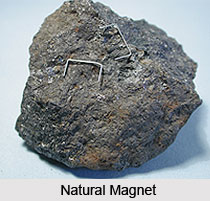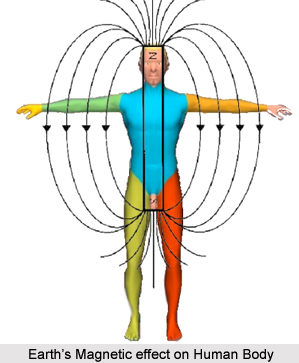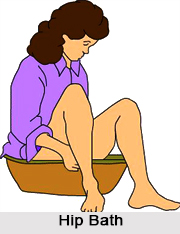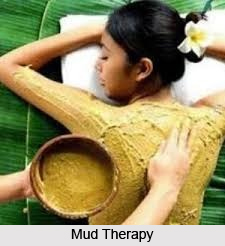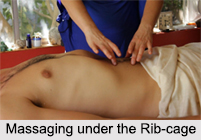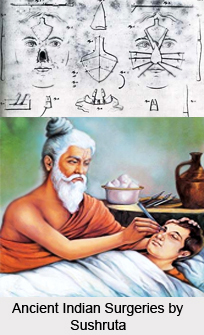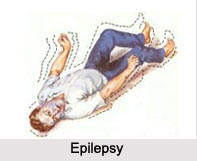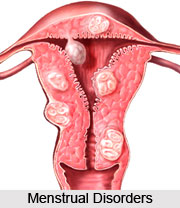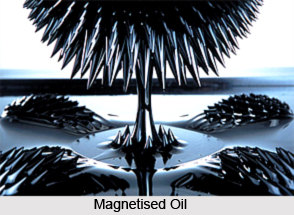Introduction
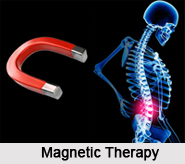 Magnetic Therapy is a science as well as an art, postulating knowledge of human organisms and the expertise to cure through the appropriate application of Magnets. This alternative branch of medicine, also known as "Magnet Therapy", "Bio Magnet Therapy" or "Magno Therapy", is evidently, far-reaching in terms of possibilities in physical as well as mental disorder treatment through exposure to the magnetic fields. Magnetic therapy utilizes the natural energy of magnetism that is important to human existence and overall health.
Magnetic Therapy is a science as well as an art, postulating knowledge of human organisms and the expertise to cure through the appropriate application of Magnets. This alternative branch of medicine, also known as "Magnet Therapy", "Bio Magnet Therapy" or "Magno Therapy", is evidently, far-reaching in terms of possibilities in physical as well as mental disorder treatment through exposure to the magnetic fields. Magnetic therapy utilizes the natural energy of magnetism that is important to human existence and overall health.
Magnets designed specifically for human applications contain the power to interact with the energy system of the body, in order to create a distinct field for efficient cellular and hence organic activities. Be it localised or generalized application of magnets, the outcome tends to be visible on the basic functioning of cells, and is thereby reasoned to be effective.
History Of Magnetic Therapy
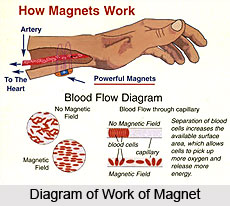 History of Magnetic Therapy deals with the science of the most ancient times. The curiosity of the human race in concern with magnets has been inevitable. Several civilizations have conferred utmost eminence to the use of magnets with the ability to create a difference in our life as well as well being.
History of Magnetic Therapy deals with the science of the most ancient times. The curiosity of the human race in concern with magnets has been inevitable. Several civilizations have conferred utmost eminence to the use of magnets with the ability to create a difference in our life as well as well being.
The first record of the discovery of a magnet dates back to 600 B.C. It is believed that a boy-shepherd named Magnes, while roving about on Mount Ida was awe-struck with the effects of a lodestone on his iron-capped staff. The word Magnet is said to be derived from that his name. Another theory states that the word "Magnet" is derived from the place Magnesia in Asia Minor, where this stone was discovered in abundance. The early centuries of the Christian era witnessed the emergence of a magnet compass in China for navigation.
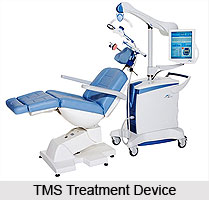 Ancient Egyptians referred to "Magnets" as "lodestones", and vividly used them to prolong life and improve vigour. It is held that, Cleopatra wore a polished lodestone on her third eye, with a conviction that it helped maintain her youth and beauty. In 46 AD, the physician Scribonius Largus suggested the use of the electric torpedo fish to cure headaches and gouty arthritis. The ancient Romans also used magnetic therapy to treat eye disease. The French physician Marcel used it to treat headaches, and the Islamic physician Avicenna (980 - 1037) used magnetic treatment to treat depression of the patient. In more recent times, Paracelsus (1493-15410), considered the father of modern medicine, believed that the force found in magnets mainly influenced the life force of the body. The belief underwent several, sturdy manifestations in Europe, Russia, China, Japan and other countries. Scores of civilizations are replete with the incorporation of Magnetic stones in their daily and therapeutic life. The ancient times provide countless references to Magnetic Healing. Several anecdotal accounts in the Bible vouch for a variety of such happenings as miracles.
Ancient Egyptians referred to "Magnets" as "lodestones", and vividly used them to prolong life and improve vigour. It is held that, Cleopatra wore a polished lodestone on her third eye, with a conviction that it helped maintain her youth and beauty. In 46 AD, the physician Scribonius Largus suggested the use of the electric torpedo fish to cure headaches and gouty arthritis. The ancient Romans also used magnetic therapy to treat eye disease. The French physician Marcel used it to treat headaches, and the Islamic physician Avicenna (980 - 1037) used magnetic treatment to treat depression of the patient. In more recent times, Paracelsus (1493-15410), considered the father of modern medicine, believed that the force found in magnets mainly influenced the life force of the body. The belief underwent several, sturdy manifestations in Europe, Russia, China, Japan and other countries. Scores of civilizations are replete with the incorporation of Magnetic stones in their daily and therapeutic life. The ancient times provide countless references to Magnetic Healing. Several anecdotal accounts in the Bible vouch for a variety of such happenings as miracles.
During the time of Vedic Civilisation, around 4000 BC, the Vedas came into being. This set forth assistance on all aspects of life, religion, customs, traditions and cures of diseases through various healing agents. The ancient Indians trusted the healing properties of magnet and therefore, employed it for curing several diseases. Several ancient Vedic scriptures include references to the use of magnets in the treatment of various diseases. They also provide explicit guidelines for the use of north and south poles of magnets, each pole dealing with a certain specific disease.
Similarly, Atharva Veda, a scholarly treatise which formed the basis for Ayurveda (also called as science of life), involves a number of mantras in chapters 1 to 4, which provides particulars for the usage of magnets for arresting bleeding in women, sterility, etc. The magnets in Sanskrit are referred as Ashman or Ashna.
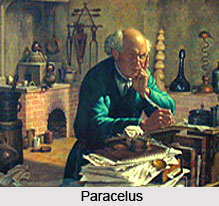 Similarly, many advanced civilizations were also dealt with the exploration and usage of magnets. The Greeks in 800 BC were familiar with the properties of the magnet or the lodestone as it was termed earlier. The Greek scholars like Plato, Homer and Aristotle in their masterly works detail these healing properties out. A famous Swiss alchemist and mystic, Parcelsus profoundly studied the subject of Magnetism. He attributed numerous properties to the magnet and emphasized on the magnetic treatment. He also said that the magnet has certain qualities to cure patients. The magnet attracts all tumours that are in the human system. The magnet, is therefore, highly useful in inflammations, influxes and ulceration, in diseases of intestine and uterus and in internal as well as external diseases.
Similarly, many advanced civilizations were also dealt with the exploration and usage of magnets. The Greeks in 800 BC were familiar with the properties of the magnet or the lodestone as it was termed earlier. The Greek scholars like Plato, Homer and Aristotle in their masterly works detail these healing properties out. A famous Swiss alchemist and mystic, Parcelsus profoundly studied the subject of Magnetism. He attributed numerous properties to the magnet and emphasized on the magnetic treatment. He also said that the magnet has certain qualities to cure patients. The magnet attracts all tumours that are in the human system. The magnet, is therefore, highly useful in inflammations, influxes and ulceration, in diseases of intestine and uterus and in internal as well as external diseases.
Parcelus, with his systematic experiments and observations paved way for the modern art of magnetic healing. Therefore he is often and correctly described as the `father of Magnetotherapy`.
The ancients attribute some more qualities to Magnets as:
* The lodestone could draw out path from the body by dilating the vessels.
* They could act as a purgative agent.
* Magnets could help in quickly healing wounds.
* They could also cure several diseases like gout, dropsy and hernia.
The king of Zeilan went upto the extent of demanding that his meat be served only in the lodestone dishes. He staunchly believed that this act maintained his youth and vigour.
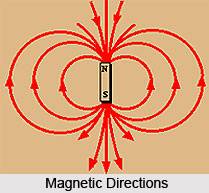 One of the most interesting beliefs of ancient times remains that; the magnet has a `soul` as it moved iron. Therefore it was used to detect infidelity in women, who, according to the ancient belief, could not lie comfortably in bed with their husbands when the magnet was placed under their pillows.
One of the most interesting beliefs of ancient times remains that; the magnet has a `soul` as it moved iron. Therefore it was used to detect infidelity in women, who, according to the ancient belief, could not lie comfortably in bed with their husbands when the magnet was placed under their pillows.
The magnet and magnetism were a common application in the life of the early Egyptians. The Egyptian mummies of Pharaoh, who have been the restorers of culture through the ages, possess a strategic arrangement of magnetism that prevents their degeneration and decay. Not only that, a legion of wondrous phenomena has been attributed to the pyramidal dimensions, which are based on certain subtle laws of magnetism.
On further research, it was discovered that even the curd, wines and other foodstuffs capable of perishing, kept in the man-made wooden pyramids made with dimensional accuracy derived from the knowledge of the ancient pyramids, are kept intact for incredibly long periods.
The magnetic harmony of the human body has been studied and incorporated in a very ancient Hindu custom, according to which, a person in his final days, should be tied down to the ground (not on the cot) in the north-south direction-head towards north and feet towards south to induce magnetic parallelism between the earth and the body. This was believed to bring peace, tranquillity, and mitigation of pain and less suffering while leaving the ephemeral world. The custom is even practiced in modern times, though in much rarity.
The ancient work of literature clearly details the nature and quality of magnetism of the earth and other celestial bodies in the universe along with their effects on human beings. The age-old custom of fasting on new moon and full moon days stems from the observation that the lunar effect on human brain on these days when all the martial tumours in the body are greatly attracted by the moon is tremendous. This can lead to severe mental or emotional problems.
Magnetic healing in medieval times
Although the magnet was considered a powerful entity, it had settled into oblivion due to many reasons. The use of the magnet was almost forgotten until the fourteenth century A.D. The period following the fifteenth century saw a variety of constructive discoveries concerning the earth`s magnetism and the inventions of electricity, electromagnetism, electromagnetic inductions, etc.
Renowned scientists such as Michael Faraday (1791-1867), A.M. Ampere (1775-1836), H.C. Oersted (1777-1851) and others made some of the most significant contributions in the fields of electricity and magnetism. These discoveries constituted the base for further utilization of these natural forces in a number of modern electronic gadgets such as loud-speakers, motors, radios, scooters, calculators, computers, etc.
Apart from these, the therapeutic properties of magnets in modern times saw a major milestone in the era of Paracelsus. It was he who announced that the stars and magnets emitted a subtle force, which saturated space and influenced man.
His observations inspired modern scientists to conduct bio magnetic experiments on plants, animals and human beings. Uan Helmont (1577-1664 A.D.) believed that a magnetic fluid radiates from men and may be guided by their will to influence the minds and bodies of others. It was Uan who propounded the doctrine of animal magnetism.
During the eighteenth century A.D., Dr Hahnemann, the founder of Homeopathy, and Dr F.A. Mesmer discovered ways to generate various cures by stroking people`s body with magnets. They directed their efforts in constructing systematic use of magnets in the treatment of human ailments and came up with astounding results. The former used magnetic rods in the cure of diseases and concluded after a great deal of experimentation that, a magnetic rod can speedily and permanently cure the severe most disease.
Dr Hahnemann also prepared three homoeopathic medicines by saturating the sugar within milk and alcohol with the omnipotent emanations of the North Pole, South Pole and the entire magnet. He named these medicines as "Magnetui polus arclicus", "Mugnelus polus ousiralis" and "Magnetus polus ambo" respectively, which are brought into use even today by homeopaths the world over.
Magnetic Healing in Modern Times
Although magnetic healing resolved into oblivion due to several reasons, in the past decades, nevertheless, an interest was aroused in the scientific temperament of the modern man as it offered an assurance of cure of some recent diseases like cancer which have defied the conventional modes of treatment.
The modern scientists, physicists, pharmacists, physicians and surgeons planned and set out statistically designed experiments on the biological effects of magnets. But their conclusions only corroborated the observations of the ancient times. Additionally, the experts also formulated these studies into sound and scientific theories of bio magnetism.
Various scientists, specially the ones from USA, USSR, Puerto Rico, Japan and Germany, have published numerous reports, establishing the therapeutic effects of different types of magnets. An extensive research on the effects of magnets on bacteria, glands, etc. has been conducted. The research on the use of magnets on human beings has obtained following conclusions:
* Magnets are found useful for the treatment of heart and other allied conditions.
* Few results are obtained on the control of tumours and cancers with the help of strong magnetic fields. In fact, many cases of advanced cancer have found to be cured with the use of magnets.
* Magnets also influence innumerable morbid affections.
The Russians have conducted experiments on magnetized water and its application in dissolving the deposits of unwanted salts in radiators and boiler water pipes, and subsequently in dissolving kidney stones and gall bladder stones. Also, irrigating the plants with magnetized water produces large-sized tomatoes and brinjals. Similarly, the cows were observed to provide more milk with the aid of magnets.
In Italy, the systematic experiments on clinical effects of magnets of painful afflictions like rheumatism revealed that a magnet was an infallible tool in mitigation of pain and enhancing mobility in patients suffering from crippling diseases.
In India, a number of Magneto-therapists, through systematic and well-experimented records, have proved beyond doubt that the magnet is highly useful in healing painful afflictions like cervical Spondylosis (degenerative changes in the neck), sciatica, rheumatism, eczema, urinary disorders, etc.
All the above cases are an irrevocable proof of the possibilities that magnetic healing can offer and a new hope to the patients suffering from grave diseases. Besides, superior results have been obtained in the treatment of leucoderma, dysmenorrhoea (painful menses in women), blood pressure, asthma and rheumatoid arthritis. Even under incurable conditions called enclosing Spondylosis (in which the entire spine is fused and stiff like a wooden plank) the magnet helps in reducing pain and enhancing the mobility of the spine.
First Treatise on Magnetochemistry in India
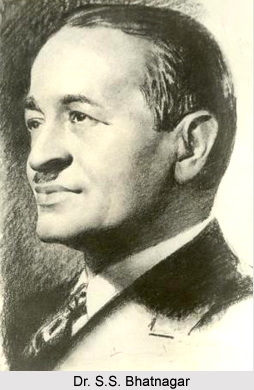 First treatise on Magneto chemistry in India was written in English by Dr. S.S. Bhatnagar and Dr. K.N. Mathur, in the year 1935. This dealt with the physical principles and the application of Magneto chemistry. In this particular subject, they studied mainly on oxidation.
First treatise on Magneto chemistry in India was written in English by Dr. S.S. Bhatnagar and Dr. K.N. Mathur, in the year 1935. This dealt with the physical principles and the application of Magneto chemistry. In this particular subject, they studied mainly on oxidation.
This particular book on Magneto chemistry provides an excellent summary of the work on Magneto chemistry. The notable contributions of Dr. S.S. Bhatnagar, M. Sc. (Punjab), D. Sc. (London) in the field of Magneto chemistry are also discussed here. For this work on Magneto chemistry, he won an award of rupees one lakh which he later donated to a University. This work earned him the title `knight` in 1941 and was awarded `Padma Vibhushana` in 1954. He expired on the 1st January, 1955. Thereafter, many further experiments in Isomagnetics and other aspects of Magnetotherapy or Magnetic Therapy are going on in India.
This book on Magneto chemistry inspired the modern time people to use this ancient knowledge about the therapeutic quality of the magnet. Thus, the magnet treatment has been revived during the last 200 years and is being developed now with the hope of increasing the utility of magnet as a healer of human sufferings.
Advantages of Magnetic Therapy
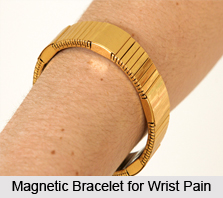 Advantages of Magnetic Therapy or `Magnetotherapy` are innumerable and known to have benefited people suffering from various ailments. Magnetotherapy does not require any other medicine when it is employed to treat other people. Magnetotherapy is a natural treatment, based on natural laws and works in conformity with the nature and is an aid to natural processes of healing. Therefore, it has no harmful effects, which could endanger the life of a patient. The Magnetotherapy can be taken alone or along with any other treatment. It does not hamper any medical treatment but helps to accelerate the action of all medicines, which have the effect of restoring the ailing body to its normal state in a natural way. Moreover, this medical treatment is inexpensive and easy to apply on the different body parts.
Advantages of Magnetic Therapy or `Magnetotherapy` are innumerable and known to have benefited people suffering from various ailments. Magnetotherapy does not require any other medicine when it is employed to treat other people. Magnetotherapy is a natural treatment, based on natural laws and works in conformity with the nature and is an aid to natural processes of healing. Therefore, it has no harmful effects, which could endanger the life of a patient. The Magnetotherapy can be taken alone or along with any other treatment. It does not hamper any medical treatment but helps to accelerate the action of all medicines, which have the effect of restoring the ailing body to its normal state in a natural way. Moreover, this medical treatment is inexpensive and easy to apply on the different body parts.
In Magnetotherapy, the body comes continuously in contact with magnets, which generates warmth in body, activates the whole working system and accelerates blood circulation. Thus it provides strength and tones up the body as a whole. Magnetotherapy helps in faster recovery from ailments, removes, tiredness, weakness, proves beneficial in recovery periods. It also reduces pains and swellings of every part of the body.
Magnetotherapy is beneficial for light conditions as well as for serious diseases. It also helps those who are not mentally satisfied with their lives. The depressed persons can also get advantage by using Magnetotherapy. It is very advantageous for the hurried, tense business executive, the worried nervous housewife, the career women unable to find mental peace and the child who is enraged by continued temper tantrums. One can enjoy a better and peaceful life after using the magnets. Magnetotherapy has also cured numerous cases of serious sickness, which were considered incurable by efficient doctors. Many patients were also recovered by Magnetotherapy from many incurable diseases like cancer, chronic arthritis, eczema, high blood pressure, poliomyelitis, prostate enlargement, rheumatism, insomnia, etc.
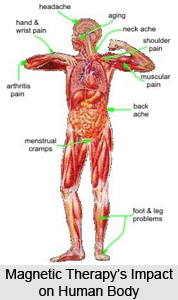
The treatment by using magnets is so simple that it can be given or taken at any time, at any place and at any part of the body. Person of any age or sex or age can take the Magnetotherapy treatment. It gives quick and lasting relief in some diseases, especially in toothache, sprains, etc. Sometimes only one sitting with magnet is sufficient and even a second sitting is not required.
In the process of Magnetotherapy, one does not need to take any preparation to give or take this treatment. It can be done only by touching the magnets for some time. Only 10 minutes use once a day is enough so it does not consume much time also. The magnet can be taken to the workplaces or in long journeys also and can be used there. This treatment does not require water, tea or milk as in it no medicine is needed to take internally. In the Magnetotherapy treatment, several patients can use the same magnets, each day, without washing, cleaning or disinfecting them. The same magnets can also be used for all complaints, if the size, shape, design and power of the magnets are suitable for the parts of the body where they are to be applied and for the diseases.
The Magnetotherapy treatment is not habit forming. If the person using the magnets does not use them for some days or weeks, he does feel anything wanting or any urge for using them. The users of the magnets remain fresh, energetic and youthful. The magnet used in the Magnetotherapy has a special property of improving and removing pain from any cause. The treatment with magnets does not result any shock or irritation as is sometimes observed in some other systems of treatment. The permanent magnets used in the Magnetotherapy treatment, retain their power for several years. They can be recharged to regain their lost magnetism if they lose their power in due course of time.
Theories for Magnetic Therapy
Two theories are used to elucidate the magnetic therapy. The primary theory asserts that, magnets affect the electrical current in cells. When magnets are functional on the afflictive region of the body, the nerves in that area stimulate, thus discharging the body"s innate painkillers. This is responsible for the application of magnets for pain relief.
According to the secondary, but equally relevant magnetic therapy theory, when magnets are applied to a painful area of the body, the cells in that area respond to increased blood circulation, ion exchange, and oxygen flow to the area. Magnetic fields attract and repel charged particles in the bloodstream, thus increasing blood flow and producing heat. Increased oxygen in the tissues and blood stream is considered to create a significant difference in the pace of healing.
Treatments in Magnet Therapy
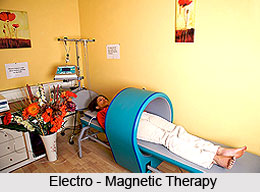 In general practice of Magnetotherapy or Magnet Therapy, common ailments such as pain and swelling in one part or simple headache are not encountered much. Rather, multiple complaints such as cervical spondylosis with extension of pain to right or left hand along with the complaint of pyorrhoea are a common occurrence.
In general practice of Magnetotherapy or Magnet Therapy, common ailments such as pain and swelling in one part or simple headache are not encountered much. Rather, multiple complaints such as cervical spondylosis with extension of pain to right or left hand along with the complaint of pyorrhoea are a common occurrence.
If the above-mentioned example is taken into consideration, the nature of complaints decides a specific application of magnets for all the symptoms. For instance, in this case the North Pole should be applied to the painful vertebra in the neck and the South Pole to the extremity to which the pain extends. Additionally, the North Pole should be applied to the affected side of the cheek for annihilating the infection and pus formation. In addition to this basic treatment, magnetized water should also be taken to rid the organism of pus, which circulates in the system.
Examination of Patients by Magnet Therapy
In order to reach a consensus of diagnosis, thorough examination of the body is required. Any complaint of a patient should be thoroughly examined to obtain maximum information on the disease.
In case of pain in the knees, look out for the presence of redness. In case of any pain enquire whether the pain radiates to the thigh or the foot or the calves. Thorough information like if the chief complaint is accompanied by any other unrelated problems like scanty and painful urination or any disorder of menstruation in women patients should also be obtained. Observe any swelling in the neck, which may suggest enlargement of thyroid or swelling and enlargement of liver or spleen or any of the lymph nodes in the neck, armpit, etc.
Only when the total symptoms persisting in the whole body is studied that the accurate diagnosis is made to select a proper cure.
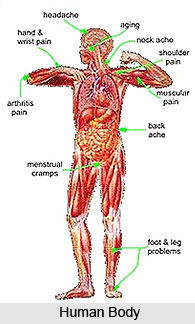 Interrogation of the Patient by Magnet Therapy
Interrogation of the Patient by Magnet Therapy
Symptoms of a disease can be best diagnosed through the patient himself. The patient should be asked to narrate his complain in his own words. Questions should be put to him to ascertain the exact location of the pain, its extension time of aggravation of various complaints and functioning of his body systems. In women patients, information on menstruation is very important.
The above aspects will not only help to decide the correct mode of application of magnets but also the type of accessory treatment to be recommended to the patient for an Integrated Approach to the disease.
The importance of proper care taking and observation of the important symptoms play an important role in prescribing whether the North or South Pole treatment is needed; or gargling with north-pole water should be recommended. In short, a magnetic treatment is based on the correct diagnosis only.
Posture during Magnetic Therapy
The acquisition of proper posture during magnetic therapy is also of great importance. Whether sitting, or lying down, the posture should be in accordance with terrestrial magnetism to derive-maximum benefit during magnetic treatment.
Preparing for the treatment, a patient should sit comfortably on a chair or sofa removing his footwear. It is not advisable to sit on the ground while taking the treatment, as insulation is must between the magnets and the subject.
The recipient can face any direction while taking general application. But the local application requires particular positioning of the body. While applying the South Pole locally, face the north direction and vice versa to ensure the full power of the magnetic lines of force.
While providing therapy to old and debilitated patients, the magnetic application should better be taken by the patient in the supine position rather than in the sitting position. In such cases, the magnets can be kept on the two sides of the patient and the hands rested on them. The magnets can also be kept under the shoulder or back in the supine position. This mode of magnetic application is found most convenient in paralytic patients. Nevertheless, little imagination combined with common sense can guide one to choose the most appropriate seating position for the patient. For example, in case of application of magnets against painful piles, the two magnets can be kept side by side. The patient can sit over them. In case the patient finds the magnets too hard, a thin cushion may be provided over the magnets. Otherwise, alternatively general application may be resorted to in such cases.
The magnetic emanations can easily pass through cloth. As a precautionary measure, the patient should also avoid taking treatment near a fire or a direct source of heat as it may adversely affect the magnetic properties of the permanent magnets.
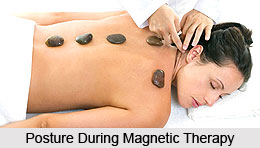 Duration of Magnet Therapy
Duration of Magnet Therapy
The total time duration of magnetic therapy depends heavily upon factors such as severity and length of disease, individual susceptibility, age of the patient, organs to which magnets are to be applied and the strength of the magnet. In most cases, each `sitting` should be for duration of 10 to 30 minutes. Prolonged exposure for even 45 minutes may be allowed in cases of paralysis, rheumatoid arthritis, polio and sciatica. In any case, the above-recommended period of exposure applies to treatment with magnets not exceeding 2000 gauss, and definitely not for extra-strong magnets with higher gauss powers.
It is absolutely necessary to stick to the appropriate periods of exposure as longer exposures may lead to over-excitement of tissues.
Like any other medication, every medicinal substance has a safe dose. The `dose` of magnetism for every individual should be worked out on the basis of the following considerations.
•
Severity and length of disease
•Individual susceptibility to magnets
•Age of the patient
•Strength of magnets
Length of Treatment
The length of treatment depends on many factors, which a magneto therapist has to consider before he can reasonably predict when the treatment will start showing results, especially in case of chronic ailments.
The major factors for consideration are as follows:
•The type of disease
•The degree of chronic disease.
•Whether the disease has so far progressed to bring about structural changes in an organ or merely functional changes have been brought
•Degree of the reactivation of the patient etc.
Treatment in magnet therapy clinical practice, along with research has shown that the diseases of recent origins yield to magnetic treatment almost immediately. In pains and swellings occurring for the first time, the magnet works faster than any analgesic.
However, in chronic cases like asthma, a patient can experience relief after 4 to 5 sittings of 30 minutes each. Further still, in some incurable conditions like alkalosis spondylosis (condition in which the spine turns stiff like a wooden board, so that a patient is unable to bend), the magnets can only relieve the pain and improve the mobility of the spine to a certain extent. But no permanent cure may be expected.
The duration for which the patient has been suffering from the disease largely affects the duration of treatment required for a complete cure. It has also been found that the individual response of a patient to magnetic treatment has an important bearing on the length of treatment.
However, in painful and crippling conditions like arthritis, a patient can expect to feel relief after about 8 to 10 regular sittings of 30 minutes each. Not to mention that the length of treatment varies from one patient to another.
It is only after a magneto therapist has taken the case and examined the nature and severity of the disease that he can guess the length of application required. Magnetotherapy is a rational and scientific system of treatment.
Precautions during Magnetic Therapy
Magnetic therapy is very potent. Hence, like any other medication, this branch should also be handled with care and precaution in order to gain maximum benefits and to avoid certain unwanted reactions in certain sensitive cases. A consideration is necessary in the use of magnets due to their intrinsic properties of improving the circulation, generation of heat, etc. These precautions are given below.
•Do not intake any cold drinks or eatables during or after the application of magnets, as they may unnecessarily dampen the effect of heat produced during application. For the similar reasons, a cold bath should also be avoided immediately after the app- ration for at least an hour. However, hot drinks can be taken during or after the application.
•Immediate applications of magnets after a full meal should be avoided for at least two hours. There can be a sensation of nausea or vomiting if magnets are applied immediately after a meal. Also, the blood circulation is mainly geared towards the alimentary canal soon after meals. Hence, the efficiency of the magnetic application may be considerably reduced.
•Do not apply strong or medium-power magnets to delicate parts like brain, heart or eyes. Ceramic magnets are suitable for application to these organs for not more than 15 minutes.
•Pregnant women should not apply strong magnets of SEM or SUM type as these may sometimes induce abortion, especially if two similar poles such as north poles or south poles are used simultaneously. Also, medium-power and ceramic magnets should not be applied directly over the womb.
•Strong encased magnets of about 2000 gauss power have immense attractive properties. Therefore, they are clamped together forcefully when brought near each other. Even in slight carelessness, the fingers may be trapped in between and may be badly crushed.
•Except, the ceramic magnets, other magnets if not in use should be kept with a suitable keeper to avoid loss of magnetism. Care should be taken and the magnets should not be allowed to fall on hard ground or remain near a fire, as that may severely affect their magnetic properties.
•Sophisticated electrical equipments and certain clock may be severely damaged if brought in close vicinity of these strong magnets. Therefore, it is preferable to advise the patients applying magnets to remove their watches before commencing the application. The magnets should therefore be kept away from any electrical or electronic equipment.
Magnets in Homoeopathy
The founder of Homeopathy Dr. Samuel Hahnemann recommended the use of magnets in treating various diseases. Three varieties of magnetic medicines in Homoeopathy were also introduced by him. He has also written about the use of the three magnetic medicines in detecting and proving various diseases.
The use of magnets for the treatment of different human ailments, in a regular way was not given by any other branch of medical science other than in homeopathy and naturopathy. The principles of magnetotherapy and practice of Acupuncture or Acupressure seems to have close resemblance. The various `Acupuncture points` are also considered as the `magnetic points` for application of magnets on the human body.
In the same way, naturopathy also utilises the forces of nature including electricity in correcting the various human disorders, which has close similarity with different aspects of magnetotherapy. The greatest universal force of magnetism is applied in the process of treatment through magnetotherapy. This new idea of treatment has now become the topic of research by various scientific professionals. The experts in the field of magnetotherapy hope that this new approach would stimulate further thinking in the professionals and researchers, which will open up new avenues for scientific research in this field.
The integrated application of the Homeopathy or Naturopathy with magnetotherapy in the allied medical sciences may help to break the disease deadlock in many cases, for the ultimate benefit of the sick humanity. This allied treatment can make the magnetic treatment more easy and practicable. All inventions, fresh devices and new schemes in the medical arena were introduced on the basis of accumulated experiences and experiments of a number of people, sometimes of several generations. Magnetotherapy has also been developed in course of long time and many physicians, researchers and scientists have contributed towards its development. And all these contributions have been in support of the use of magnets and the magnetotherapy in Homeopathy and naturopathy.
Magneto Therapy and Acupuncture
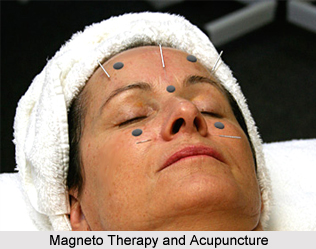 The magneto therapists have found that various acupuncture points can be utilised for Magnetotherapy or Magnetic Therapy. It can be then used for treatment of various internal ailments. In India, several physicians have now started practicing it.
The magneto therapists have found that various acupuncture points can be utilised for Magnetotherapy or Magnetic Therapy. It can be then used for treatment of various internal ailments. In India, several physicians have now started practicing it.
The term "Acu" means needle and the meaning of `puncture` is pricking. Therefore, Acupuncture means treating the patients through the art of pricking or piercing needles on some special points on the body of the patients.
In this type of treatment, a fine needle is pricked into the skin of the patient to the depth of a few millimetres and is withdrawn after a few minutes. Here, it is essential to know which point is to be pierced in a particular disease. These acupuncture points are used for Magnetotherapy treatment.
There are some tender areas at certain points on the surface of the body in all diseases and these tender areas are the Acupuncture points. If the magnet is applied in those points, the best benefit can be enjoyed. In simple acupuncture diagnosis, the patient is examined from head to toe in order to find out all the tender points to assume the internal disease corresponding to them.
It has been noticed that a disease of an internal organ produces pain, tenderness, hyperesthesia or hypoesthesia, etc. in some part of the skin. This can be verified experimentally. Then in these parts the Magnetotherapy can be applied.
Lowering Blood pressure with Magnetic Therapy
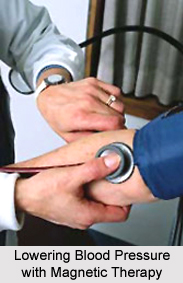 Studies in bio-magnetism reveal that a maximum drop in blood cholesterol from 222 milligrams to 141 milligrams occurred as a result of magnetic application. When the magnet was applied for a few weeks in another set of clinical trials, a positive effect on reduction of the blood pressure to the extent of 20 to 30 millimetres of mercury was observed. Many marvellous effects of magnetic treatment on the instant lowering of high blood pressure has been obtained by applying a strong south pole magnet to the right hand of the patient. The regular application of magnets can help in controlling the most common, but dreadful imbalance, which when aggravated can even cause blindness or brain haemorrhage.
Studies in bio-magnetism reveal that a maximum drop in blood cholesterol from 222 milligrams to 141 milligrams occurred as a result of magnetic application. When the magnet was applied for a few weeks in another set of clinical trials, a positive effect on reduction of the blood pressure to the extent of 20 to 30 millimetres of mercury was observed. Many marvellous effects of magnetic treatment on the instant lowering of high blood pressure has been obtained by applying a strong south pole magnet to the right hand of the patient. The regular application of magnets can help in controlling the most common, but dreadful imbalance, which when aggravated can even cause blindness or brain haemorrhage.
Improved blood circulation also leads to faster and more effective replacement of decayed tissues and faster healing of wounds. This ensures a greater number of sound and healthy blood corpuscles in the blood stream. Clinical studies in various medical institutions have proved that the application promotes health and imparts a better sense of well being by providing warmth and energy. Thus, patients undergoing magnetic treatment regularly report more stamina for work, less fatigue and a state of joy and zeal. The regulation of the flow of blood in the blood vessels ensures proper nutrition and oxygenation of different tissues in the body. This in turn leads to harmonization and improved functioning of different tissues. The health-promoting faculties of magnets endow an organism with better resistance to disease and equip it for a better and effective living.
An obvious effect of magnets on reduction of infection is evident from the results of studies aimed at certain characteristics of blood like white blood corpuscles and the erythrocyte sedimentation rate (ESR). It was observed after application of magnets that there was a marked drop in the above characteristics. This suggests that some infectious diseases like typhoid and measles can be brought in the domain of the therapeutic range of magnets.
Medical scientists have also tried magnetic applications in various infections where the antibiotics have lost their efficacy either due to the gross-mismanagement of the case by the physician or development of slow resistance by the micro organisms to the `wonder drugs`. Astonishing results have been obtained throughout the world by using the north pole of the magnet, which checks the infection and subsequent complications arising out of lack of aseptic conditions in hospital wards and operation theatres.
The pathologists have been vouching for the amazing influence of magnets on various types of wounds such as incised, punctured, crushed and infected heals rapidly by reduction in the formation of the fibrous tissue. The process of production of sound cells and rejuvenation is hastened, leading to quick recovery in painful conditions like corn`s chilblains and chaps. Under the influence of magnets, the fractured bones are known to join up speedily by hastened calcification.
Magnetic Therapy for Pain and Inflammations
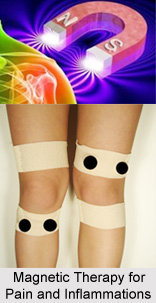 Magnetic Therapy is a pseudoscientific alternative medicine practice involving the use of static magnetic fields. Practitioners claim that subjecting certain parts of the body to magneto static fields produced by permanent magnets has beneficial health effects. According to the observation of the Swiss alchemist and physician P.A. Paracelsus, the magnet is highly useful in inflammations. This observation has been corroborated, through experiments and clinical findings by a number of bio-magnetic scientists around the world.
Magnetic Therapy is a pseudoscientific alternative medicine practice involving the use of static magnetic fields. Practitioners claim that subjecting certain parts of the body to magneto static fields produced by permanent magnets has beneficial health effects. According to the observation of the Swiss alchemist and physician P.A. Paracelsus, the magnet is highly useful in inflammations. This observation has been corroborated, through experiments and clinical findings by a number of bio-magnetic scientists around the world.
The magnet is known to reduce pain, mitigate painful swellings and inflammations and has a soothing effect on the aching organs. Clinical practice by numerous magneto therapists have established the fact time and again that different types of aches and pains like earache, toothache, headache, muscular pains, painful cramps, painful urination and painful menstruation in women quickly succumb to the soothing effects of magnets. As a matter of fact, the popularity of the magnetic system of healing in India and abroad can be surely credited to the positive effect of magnets on the mitigation of pain in any part of the body. The magnet has also come to be known as a `pain-killer`. The pain-killing effect is induced by the magnet due to an improved blood circulation to the affected part, soothing effect on the nerves and the fomentation effect produced by the impacting heat.
Magnetic devices are claimed to relieve pain and to have therapeutic value against a large number of diseases and conditions. The three fields on the basis of which the Magnetic Therapy works on human body are "increase in blood circulation", "reduce inflammation" and "speed recovery from injuries". A number of patients suffering from painful affections like sciatica, gout and rheumatoid arthritis, set out into a refreshing sleep soon after the application of magnets for a short while, proving the above concept of soothing and calming effects on nerves.
Methods of Application of Magnetic Therapy for Pain and Inflammations
Magnet Therapy is the application of the magnetic field of electromagnetic devices or permanent static magnets to the body for purported health benefits. Products include magnetic bracelets and jewellery; magnetic straps for wrists, ankles, knees, and back; shoe insoles; mattresses; magnetic blankets; magnetic creams; magnetic supplements; plasters or patches and water that has been "magnetized". Application is usually performed by the patient.
Magnetic therapy for skin and hair pigmentation
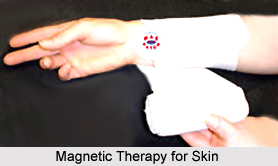 Magnetic Therapy for Skin and Hair Pigmentation is one of the most conventional treatments in India and also in abroad. Skin and hair, like any other organ in the body, happen to remain at the receiving end of magnetic properties. Similar to their effects on glands, magnets exercise a corrective effect on the function of the skin and hair.
Magnetic Therapy for Skin and Hair Pigmentation is one of the most conventional treatments in India and also in abroad. Skin and hair, like any other organ in the body, happen to remain at the receiving end of magnetic properties. Similar to their effects on glands, magnets exercise a corrective effect on the function of the skin and hair.
Skin normally secretes adequate quantities of skin pigment, which imparts colour to it. Due to the mal-function of the pigment-secreting layer of the skin, ugly white patches of leuco-derma appear on different parts of the body. Similarly, the central layer of the skin secretes sweat and skin oil, which keeps the skin soft and oily. Mal-functioning of this layer of skin leads to various skin disorders and conditions such as an excessively dry or oily skin.
Magnets have shown many regulating and beneficial effects on the skin restoring its normal tone and colour. A similar effect has been observed on the restoration of the dark pigmentation of hair. Reports indicating that the dark colours being restored from the silvery white hair are on the rise.
Application of Magnets and magnetized water is proving to be the most effective and beneficial boon for millions of people suffering from leucoderma and premature greying of hair.





